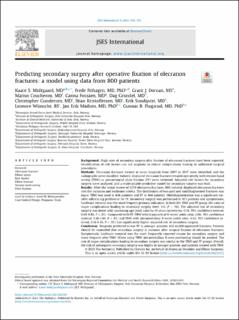| dc.description.abstract | Background: High rates of secondary surgery after fixation of olecranon fractures have been reported. Identification of risk factors can aid surgeons to reduce complications leading to additional surgical procedures. Methods: Olecranon fractures treated at seven hospitals from 2007 to 2017 were identified, and the radiographs were classified. Isolated, displaced olecranon fractures treated operatively with tension band wiring (TBW) or precontoured plate fixation (PF) were reviewed. Adjusted risk factors for secondary surgery were analyzed, and a multivariable predictive model for secondary surgery was built. Results: After the initial review of 1259 olecranon fractures, 800 isolated, displaced olecranon fractures met the inclusion and exclusion criteria. The distribution of two-part and multifragmented fractures was equal. TBW was used in 636 patients and PF in 164 patients. Multifragmentation was a significant variable influencing preference for PF. Secondary surgery was performed in 41% patients and symptomatic hardware removal was the most frequent primary indication. In both the TBW and PF group, the rates of major complications leading to secondary surgery were 13% (P = .96). The adjusted risk of secondary surgery was lower with increasing age (odds ratio by 10 years increments, 0.74; 95% confidence interval, 0.68-0.80, P < .01). Compared with PF, TBW with transcortical K-wires (odds ratio, 2.06; 95% confidence interval, 1.36-3.14; P < .01) and TBW with intramedullary K-wires (odds ratio, 4.32; 95% confidence interval, 2.16-8.86, P < .01) had significantly higher adjusted risk of secondary surgery. Conclusion Surgeons preferred to use PF in younger patients and multifragmented fractures. Patients should be counseled that secondary surgery is common after surgical fixation of olecranon fractures. Symptomatic hardware removal was the most frequently reported reason for secondary surgery and more frequent after TBW. When using TBW, intramedullary K-wire positioning should be avoided. The rate of major complications leading to secondary surgery was similar in the TBW and PF groups. Overall, the risk of subsequent secondary surgery was higher in younger patients and patients treated with TBW. | en_US |

